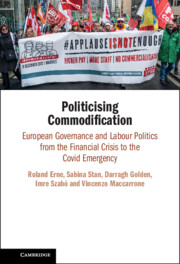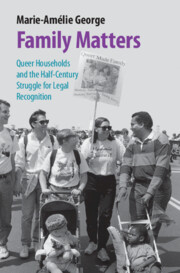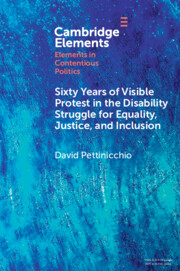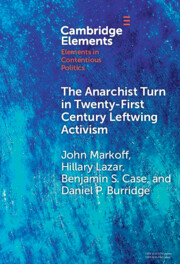293 results
Introduction
-
- Book:
- Family Matters
- Published online:
- 27 May 2024
- Print publication:
- 31 July 2024, pp 1-28
-
- Chapter
- Export citation
5 - Not Only Red
-
- Book:
- Streetscapes of War and Revolution
- Published online:
- 30 May 2024
- Print publication:
- 06 June 2024, pp 207-252
-
- Chapter
- Export citation

Politicising Commodification
- European Governance and Labour Politics from the Financial Crisis to the Covid Emergency
-
- Published online:
- 30 May 2024
- Print publication:
- 06 June 2024
-
- Book
-
- You have access
- Open access
- Export citation

Family Matters
- Queer Households and the Half-Century Struggle for Legal Recognition
-
- Published online:
- 27 May 2024
- Print publication:
- 31 July 2024
2 - How Union Organizations Shape Teacher Mobilization
-
- Book:
- Mobilizing Teachers
- Published online:
- 16 May 2024
- Print publication:
- 23 May 2024, pp 13-34
-
- Chapter
- Export citation
4 - Organizational Consolidation in Mexico
-
- Book:
- Mobilizing Teachers
- Published online:
- 16 May 2024
- Print publication:
- 23 May 2024, pp 70-88
-
- Chapter
- Export citation
8 - Factionalism in Colombia
-
- Book:
- Mobilizing Teachers
- Published online:
- 16 May 2024
- Print publication:
- 23 May 2024, pp 153-170
-
- Chapter
- Export citation
6 - Organizational Weakening in Argentina
-
- Book:
- Mobilizing Teachers
- Published online:
- 16 May 2024
- Print publication:
- 23 May 2024, pp 111-130
-
- Chapter
- Export citation
Fighting against assisted dying in Spain: catholic-inspired civic mobilization during the COVID-19 pandemic
-
- Journal:
- Politics and Religion , First View
- Published online by Cambridge University Press:
- 15 May 2024, pp. 1-26
-
- Article
-
- You have access
- Open access
- HTML
- Export citation
Reproducing socio-ecological life from below: Towards a planetary political economy of the global majority
-
- Journal:
- Review of International Studies / Volume 50 / Issue 3 / May 2024
- Published online by Cambridge University Press:
- 06 May 2024, pp. 514-533
- Print publication:
- May 2024
-
- Article
-
- You have access
- Open access
- HTML
- Export citation
The Chilean Christians for Socialism Movement: Liberationist, Third Worldist, and Utopian
-
- Journal:
- Latin American Research Review ,
- Published online by Cambridge University Press:
- 29 April 2024, pp. 1-18
-
- Article
-
- You have access
- Open access
- HTML
- Export citation
5 - Immigrant Organizing and Activism
- from Part I - Organizing and Activism
-
-
- Book:
- The Cambridge Handbook of Community Empowerment
- Published online:
- 18 April 2024
- Print publication:
- 25 April 2024, pp 139-161
-
- Chapter
- Export citation
Between Land Reform and Postcolonial Frustration: Understanding the Social Roots of Local Opposition to the PAIGC/PAICV in Santo Antão, Cabo Verde, 1975–91
-
- Journal:
- The Journal of African History , First View
- Published online by Cambridge University Press:
- 24 April 2024, pp. 1-17
-
- Article
-
- You have access
- Open access
- HTML
- Export citation
Explaining the distinction between religious and political activism in Islamism: evidence from the Tunisian case
-
- Journal:
- Politics and Religion , First View
- Published online by Cambridge University Press:
- 15 April 2024, pp. 1-19
-
- Article
-
- You have access
- Open access
- HTML
- Export citation
3 - Democracy in a Diabolical Soundscape
-
- Book:
- Deliberative Democracy for Diabolical Times
- Published online:
- 28 March 2024
- Print publication:
- 04 April 2024, pp 52-86
-
- Chapter
- Export citation
Towards an Energetics of Class: Comparing Energy Protests in India and the United States
-
- Journal:
- Comparative Studies in Society and History , First View
- Published online by Cambridge University Press:
- 01 April 2024, pp. 1-29
-
- Article
-
- You have access
- Open access
- HTML
- Export citation
#Resistencia: Indigenous Movements, Social Media, and Mobilization in Latin America
-
- Journal:
- Latin American Research Review ,
- Published online by Cambridge University Press:
- 19 March 2024, pp. 1-20
-
- Article
-
- You have access
- Open access
- HTML
- Export citation

Sixty Years of Visible Protest in the Disability Struggle for Equality, Justice, and Inclusion
-
- Published online:
- 16 March 2024
- Print publication:
- 11 April 2024
-
- Element
- Export citation

The Anarchist Turn in Twenty-First Century Leftwing Activism
-
- Published online:
- 14 March 2024
- Print publication:
- 11 April 2024
-
- Element
- Export citation
10 - Social Justice or Sexual Justice?
-
-
- Book:
- Social Justice in Twentieth-Century Europe
- Published online:
- 29 February 2024
- Print publication:
- 07 March 2024, pp 205-223
-
- Chapter
- Export citation



